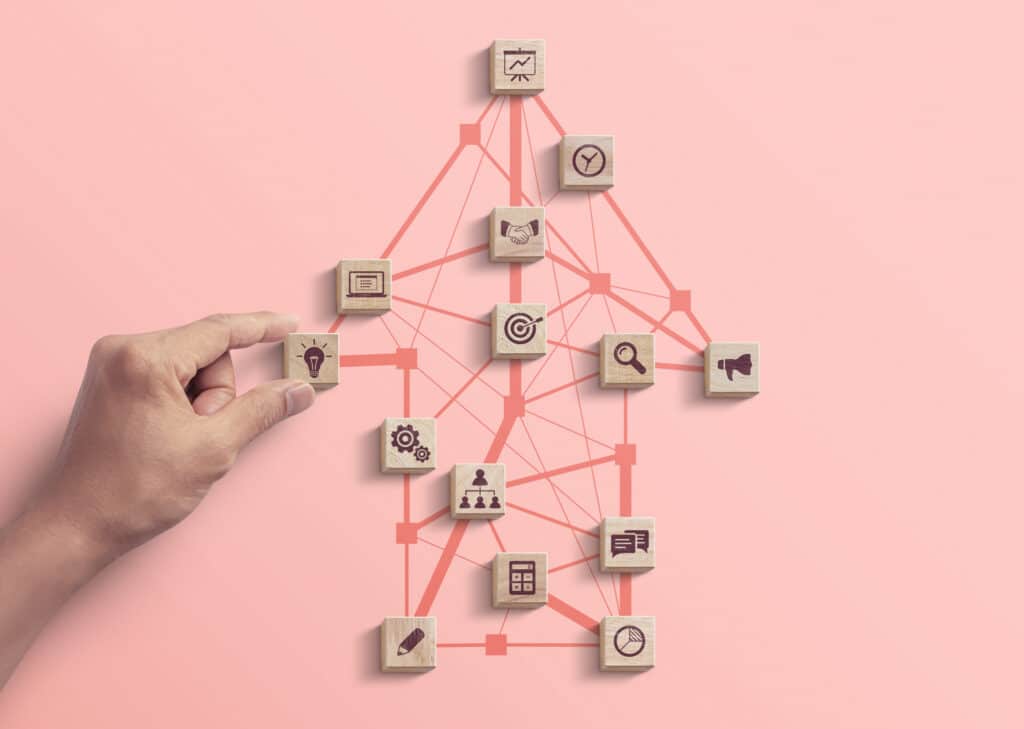Customer Relationship Management puts the customer at the center of attention – and thus binds them to the company in the long term. With these four strategies, you too can achieve this.
Table of Contents
ToggleCustomer relationship management: Why does it make sense for me?
It is the strategy that opens up completely new ways for companies to deal with their customers: customer relationship management(CRM). The aim is to focus on the customer and all their needs, i.e. support is built around the respective customer in order to provide them with more individual support and thus retain them. This is not about a contractual relationship, but rather a bond that is based on the customer’s satisfaction and trust in the company. The aim is to achieve higher recommendation rates in order to acquire new customers, build and maintain personal relationships and retain existing customers in the long term.
Customer loyalty through trust - how it works
CRM can only succeed with a clear strategy: companies need to get to know their customers better, document, collect and analyze customer data – like a patient file – work out profiles and gain an overview of customer groups in order to strengthen customer loyalty in a targeted manner.
That sounds all well and good in theory, but how can CRM be implemented in the company in concrete terms? There are various approaches. Every company, whether small, medium-sized or large, has to decide for itself which strategy suits it best. An overview.

Do it networked: Get in touch with customers via social CRM
Social CRM, also known as SCRM, is a new trend in customer relationship management. In the SCRM strategy, existing and potential customers are involved in a collaborative dialog via the Internet, especially via social media platforms such as Facebook, Instagram and Co. as well as other digital channels. This approach is particularly effective, as this is often precisely where customers communicate. First and foremost, it is important for entrepreneurs to find the right network. So the key question is: Where do my potential customers move?
Dialogue instead of monologue: listening and reacting
The next step is to actively get in touch with the customer and establish conversations with interested parties via the communication channels of social networks. The goal: customers should not only become aware of the company or the product; they should participate, for example via help forums or surveys on the further development of a product – for example, new ideas for the flavor of a drink. In doing so, the customer becomes particularly involved with the product and thus – quite unconsciously – builds up a relationship with the company. At the same time, new insights and knowledge about customers are collected, for example via web monitoring. Competitions or prize draws for vouchers can also trigger a reaction in potential customers.

SCRM also enables entrepreneurs to react quickly to new customer needs and short-term mood swings in order to strengthen or maintain customer loyalty. However, this also requires entrepreneurs to be highly flexible when dealing with social media – and this can tie up valuable time and capacity. The high data protection requirements also pose a major challenge. This makes it all the more important to be informed about the network of your target group and to enter into a targeted dialog.
SCRM - How it works
- Find a network of potential customers
- Establish communication channels and develop dialog
- Allowing customers to participate in their own processes
- Gathering new knowledge about customers
- Responding quickly to customer needs
Make it fun: arouse customer interest with gamification
Is the product complex and very difficult for the customer to understand? Then gamification can help! This strategy makes it possible to present complex content to interested parties in a simple way with the help of game-like elements so that they can internalize it more quickly and easily. For a long time, gamification was mainly used in the entertainment and advertising industry, but today it is also becoming increasingly popular in marketing.

Motivation by means of a reward system and milestones
Users are introduced to various topics interactively via different applications, games, apps and web tools. In addition, the playful engagement increases the connection to the product and thus promotes intensive customer loyalty. The games exploit the need for competition, recognition and reward, for example through stars, badges or vouchers, and success, for example through a status bar, a title or a progress bar. In this way, the customer or prospective customer is motivated to take a closer look at the product or company.
Of course, the success of gamification is heavily dependent on the attitude of users and their preference for games. Entrepreneurs therefore use them in particular to convince young people of brands or campaigns.
Gamification - how it works
- Simplify complex content with applications, apps and tools
- Arouse customer interest with the games
- Communicating information in a playful way
- Maintain motivation with a reward system
- Bind customers to the product / company with small successes
Go mobile: Respond quickly to inquiries with mobile CRM
While prospective and existing customers want to be contacted quickly and tailored to their needs, in times of digitalization, companies are increasingly faced with the challenge of systematically managing and using the flood of diverse and complex customer information. As employees are also frequently on the move – for example when visiting customers or working in the field – they often lack access to important customer data at the crucial moment. This data is usually stored in the office and has to be laboriously obtained from a colleague.

Respond to customer needs anywhere and at any time
This is exactly where mobile CRM comes into play: with the help of internet-enabled, mobile devices, all relevant data about the customer is available anytime and anywhere. This means that the customer quickly receives an answer to their query that is tailored to their profile. Mobile CRM is particularly useful for on-site appointments: for example, a service employee has access to all relevant data such as deployment dates, delivery times, invoice data or maintenance contracts at any time via their tablet while on the move. This leaves a professional and competent impression on the customer.
Once the appointment is over, the updated customer data is transferred directly to the system via the mobile device. Particularly practical: even if another employee gets in touch with the customer, they are always well informed about the status quo. The high-quality and individual service increases customer satisfaction in the long term, builds customer loyalty to the company and ultimately also encourages customers to recommend the company to other potential customers.
MCRM - How it works
- Flexible access to customer data via mobile devices
- Respond quickly to requests
- Respond to individual requests
- Different employees are equally well informed about customers
Make it connected: Recognize connections with Extended Relationship Management
Targeted and all-encompassing customer care focuses not only on interaction with the customer themselves, but also on their cross-company relationships. This is precisely where Extended Relationship Management, or XRM for short, comes in: Using software, it not only records all of the customer’s internal data, but also the associated relationships or connections to suppliers, associations and clubs, partners, investors, dealers, competitors and consultants. Even abstract data such as contracts, machines, real estate, regions or services can be included.
This provides an even more comprehensive picture of all internal and external contacts and communication processes. This gives the entrepreneur an insight into the complex links between all market participants. The cross-company view creates one hundred percent transparency and thus saves time when sifting through complex data. It can also be used to close process gaps – for example in a project where several companies are working together.
XRM - How it works
- The customer's cross-business relationships are also recorded
- Overview of complex links
- Customer is perceived holistically
- Comprehensive support taking all participants into account
- Process optimization for project work








